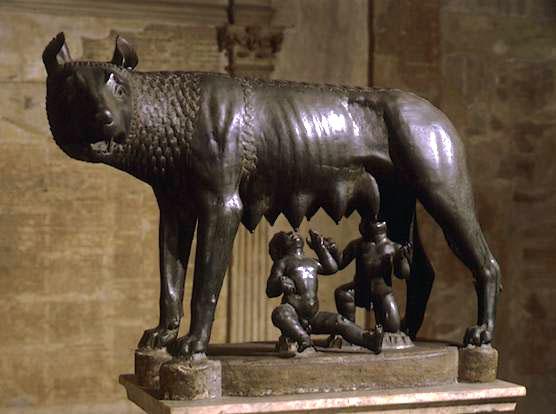Roma - Roma and the She-Wolf
 |
|
Is the origin of Roma's history, mythology or legend? Nobody knows for certain, but the history of Roma embraces a very interesting set of events that connect the ancient Greek civilization to the Romans.
This is the legend of the "Lupa Capitolina", the she-wolf that since the origins of Roma has become the symbol of the city.
One thousand years before Christ, the first settlers had come from north of the River Tevere. They were mostly shepherds and agricultural people that had settled in Etruria (Tuscany) during the second millenium (2,000 BC). At that time, the Etruscans had conquered the entire Lazio.
The great Roman poet, Virgil, (70-19 BC), in the book Aeneid, beautifully describes the seven-year odyssey of Aeneas by land and sea. After he fled with his family from Greece, Aeneas landed in the River Tevere in central Italy (approximately where the region of Lazio is today). A decade before, in Greece, Aeneas had led the Trojans in their struggle against the Greeks who, after a siege of several years, had entered the city of Troy in the belly of a wooden horse (cavallo di Troia).
Aeneas had a very difficult journey: during the crossing of the Mediterranean Sea, he lost his wife Lavinia between Thrace and Crete, then in Sicily his father died. Cast up by a storm, his ship, driven by strong winds, ended up on the African coast. Dido, the queen of Carthage (today's Libya), fell in love with him, but when Aeneas refused to marry her, she killed herself.
Aeneas sailed from Africa with his son Ascanius and finally reached the coast of Lazio, seven years after leaving Troy burning like a pyre. They settled in this new land, and after Aenea died, his son Ascanius founded the city of Alba Longa right on the area where 30 years before he had landed with his father. (Today the Alban Hills are in the area of Lake Albano, 12 miles south of Roma and only one mile north of Castel Gandolfo).
A few years later, Rhea Silvia, a beautiful Vestal, daughter of Numitor king of Alba Longa, had a romance with god Mars and gave birth to twin sons Romulus and Remus. The "Vestals" were virgins who dedicated their lives to keep the sacred fire of Vesta burning 24 hours a day. "Vesta" was the Roman hearth-goddess, a deity. The shrine of Vesta stood in the Forum, near the Regia, palace of the kings. The Vestal cult continued for centuries until the Christian emperor Constantine eliminated the worship of all ancient deities.
Amulius, Numitor's brother and new king of Alba Longa, ordered that Rhea Silvia killed for having lost her virginity and her twins drowned in the River Tevere. One of the servants eliminated Rhea Silvia, another one put Romulus and Remus in a small trough, but could not bring himself to throw the twins in the river; instead, he left them near the bank. In the morning, the babies were hungry and crying. A she-wolf happened to go by and her maternal instinct induced her to stop and nurse them. Days later the shepherd Faustulus and his wife Larentia, picked up the twins and raised them as their own children,
Twenty years later, Romulus and Remus decided to found a city. Romulus was casting a ditch where he designed the foundation of the city wall, but got in an argument with Remus and killed him. Afterwards, Romulus founded the city that he called Roma.